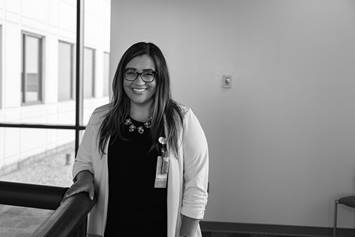Pediatric Regional Anesthesia Fellowship
Pediatric Regional Anesthesia Fellowship
Nationwide Children’s Hospital and The Ohio State University College of Medicine offer one non-ACGME accredited fellowship in pediatric regional anesthesia medicine.
The Department of Anesthesiology and Pain Medicine at Nationwide Children's Hospital and The Ohio State University College of Medicine/The Ohio State University Wexner Medical Center offer a non–ACGME accredited fellowship in pediatric regional anesthesia medicine.
We welcome all applications for an opportunity to be a leader in cutting-edge pediatric anesthetic care and perioperative pain management. Pediatric regional anesthesia continues to increase in popularity and has become an integral aspect of a balanced pediatric anesthetic.
Current anesthesia trainees and practitioners are realizing (as anesthetic subspecialties are becoming more common) to deliver safe, effective and successful pediatric regional anesthesia, further training is necessary.
Our fellowship focuses on advanced regional anesthesia techniques using ultrasound and nerve stimulation, including placing inpatient and ambulatory peripheral nerve catheters. The fellow will also manage opioid infusions and non-opioid adjuvants while acquiring knowledge of their indications, adverse effects, potential complications and everyday management.
What You Need to Know
Experience
The experience encompasses regional anesthesia for the inpatient and outpatient realms, the acute pain service, as well as exposure to the pediatric chronic pain clinic and the inpatient pediatric palliative care service.
The amount of regional anesthetics we perform monthly is among the top five pediatric institutions in the country (typically 400 – 500 blocks per quarter). We have a robust data collection system capturing information on every regional technique performed in our department, providing ample opportunities for research and quality improvement.
After developing the appropriate advanced skill-set, our fellows are involved with teaching our pediatric anesthesia fellows as well as residents. We also expect our fellows to be involved with manuscript submission and/or poster submission to national and international meetings.
The training will help develop competency in placement and management of regional anesthesia blocks (single shot and catheter, peripheral and neuraxial) and acute pain management in children of all ages. Time and opportunities for academic development in education, clinical and outcomes research focused on regional anesthesia are available.
Fellows will complete a formal 6 (or 12) month rotation in pediatric regional anesthesia and acute pain management at Nationwide Children's Hospital. The fellow will learn to employ multimodal analgesic management including the use of neuraxial and peripheral nerve injections/catheters. The regional anesthesia techniques will be performed in all age groups (infant, child, adolescent) and include upper and lower extremity blocks, truncal blocks, and neuraxial blocks (epidural catheters and spinal anesthesia).
The fellow will participate in the acute pain service, rounding on post block regional anesthesia patients, acute postoperative pain patients, as well as inpatient complex pain patients. The fellow will become comfortable managing multimodal modes of anesthesia, patient and nurse controlled anesthesia, epidural anesthesia, continuous peripheral nerve blockade, lidocaine and ketamine infusions, as well as managing opioid and benzodiazepine withdrawal.
During the fellowship, the fellow will have rotations in the outpatient pediatric chronic pain clinic, and the inpatient pediatric palliative care service. The fellow will be provided an opportunity to supervise anesthesia residents in the use of ultrasonography for peripheral and central neuraxial blocks.
Research/Scholarly Activity
Fellows will have the opportunity to participate in clinical research and will be given appropriate non-clinical time (as needed) to fulfill these goals. There will be opportunities for the fellow to become involved in research already in progress or to develop an original project. The types of activities that would suffice as academic projects include a:
- Research paper and/or case report submitted to a peer-review journal and presented
- Clinical chart review or a review article submitted to, and accepted by a peer-reviewed journal
- Book chapter or other endeavors
The fellow will have the opportunity to attend a national meeting (ASRA, IARS, SPA, ASA).
Didactics
Fellow is expected to deliver a Grand Rounds lecture, including a relevant literature review, at least once during the course of the fellowship.
Additional conference and lectures include:
- A weekly lecture series, which covers topics relevant to pain management and regional anesthesia is provided by core regional/acute pain faculty members.
- A “Journal Club” (current literature review) will be held at least once during the course of the fellowship
Schedule
- The Fellow routinely works week days from 6:45 a.m. – 4 p.m.; however, s/he will work until the case or blocks are completed.
- The Fellow will be expected to meet with the anesthesia attending on the Acute Pain Service every morning to determine potential candidates for regional anesthetic.
- The Fellow is expected to participate in Acute Pain Service rounding if not administering regional anesthesia or occupied with other clinical/scholarly work.
- The Fellow will be on home beeper for pain service occasionally during the fellowship.
- ACGME work hour rules will be maintained at all times.
Research
Research education and training are vital to the mission of Nationwide Children's Hospital and The Abigail Wexner Research Institute at Nationwide Children's Hospital. As a top-ten free-standing pediatric research center and an academic affiliate of The Ohio State University, The Research Institute has an outstanding faculty, dedicated to training and mentoring the next generation of scientists in pediatric research.
Research at Nationwide Children's Hospital
Advocacy
Advocacy training fosters and encourages interest in child advocacy by early involvement and exposure to its many aspects such as addressing social determinants of health, community collaboration, health finance, health policy and legislative advocacy.
Application & Selection
The eligible candidate will have completed a pediatric anesthesia fellowship or equivalent. We have one fellowship position available for six or 12 months. If you would like to be considered for a fellowship position, please send the following application materials to the appropriate staff listed below.
- Application
- A current curriculum vitae
- Two letters of recommendation from anesthesiologists with whom you have worked during your residency training
- A letter of recommendation from your anesthesiology training program director or chair
- A summary of your clinical experience and a brief statement explaining your interest in pursuing a fellowship position.
Inquiries and application materials should be sent to:
Department of Anesthesiology and Pain Medicine
Nationwide Children's Hospital
700 Children's Drive
Columbus, OH 43205
Publications
Manuscripts:
- Long JB, Joselyn AS, Bhalla T, Tobias JD, De Oliveira GS Jr, Suresh S; PRAN Investigators. The use of neuraxial catheters for postoperative analgesia in neonates: A multicenter safety analysis from the pediatric regional anesthesia network. Anesth Analg 2016;122:1965-1970.
- Goeller JK, Joselyn A, Martin DP, Bhalla T, Dairo O, Herz DB, Alpert S, Tobias JD. Epidural pressure changes following caudal blockade: A prospective, observational study. J Anaesth 2016;30:578-582.
- Froyshteter AB, Whitaker EE, Bryant JA, Ching CB, Tobias JD. Spinal anesthesia for urologic surgery in an infant with palliative single ventricle physiology. J Med Cases 2016;7:493-497.
- Hakim M, Burrier C, Bhalla T, Raman VT, Martin DP, Dairo O, Mayerson J, Tobias JD. Regional anesthesia for an upper extremity amputation for palliative care in a patient with end-stage osteosarcoma complicated by a large anterior mediastinal mass. J Pain Res 2015;8:641-645
- Veneziano G, Iliev P, Tripi J, Martin DP, Aldrink J, Bhalla T, Tobias JD. Continuous chloroprocaine infusion for thoracic and caudal epidurals as a postoperative analgesia modality in neonates, infants and children. Pediatr Anesth 2015;26:84-91.
- Yung A, Thung A, Tobias JD. Acetaminophen for analgesia following pyloromyotomy: does the route of administration make a difference? J Pain Res 2016;9:123-127.
- Iliev P, Bhalla T, Tobias JD. A comparison of the hourly output between the Ambu® Smart-Infuser™ Pain Pump and the On-Q Pump® with Select-A-Flow™ Variable Rate Controller with standard and overfill volumes. Pediatr Anesth 2016;26:425-428.
- Dewhirst E, Fedel G, Raman V, Rice J, Barry ND, Jatana KR, Elmaraghy C, Merz M, Tobias JD. Pain management following myringotomy and tube placement: Intranasal dexmedetomidine versus intranasal fentanyl. Inter J Pediatr Otorhinolaryngol 2014;78:1090-1094.
- Joselyn A, Bhalla T, Schloss B, Martin DP, Tobias JD. Knotted and retained caudal catheter. Saudi J Anaesth 2014;8:424-427
- Kamata M, Corridore M, Tobias JD. Thoracic epidural infusion with chloroprocaine for postoperative analgesia following epicardial pacemaker placement in an infant. J Pain Research 2014;7:609-613.
- Bryant J, Joselyn A, Tobias JD. The complicated - uncomplicated epidural placed under general anesthesia: Total spinal blockade in the post anesthesia recovery unit. J Med Cases 2014;5:564-566.
- Kako H, Beltran RJ, Krishna SG, Bhalla T, Tobias JD. Neuraxial anesthesia in the presence of clinical anticoagulation: What are our options for pediatric patients? Inter J Clin Exp Med 2015;8:1475-1481.
Review Articles:
- Kamata M, Tobias JD. Remifentanil: applications in neonates. J Anesth 2016;30:449-460.
- Goeller JK, Bhalla T, Tobias JD. Combined use of neuraxial and general anesthesia during major abdominal procedures in neonates and infants. Pediatr Anesth 2014;24:553-560.
- Joselyn A, Bhalla T, Tobias JD. Rectus sheath block. Tobias JD. AAP Newsletter Fall 2014:14-15.
Contact
For more information regarding the Pediatric Regional Anesthesia Fellowship, please contact:
Candice Burrier, MD
Program Director
Bree Bower
Program Coordinator
Bree.Bower@NationwideChildrens.org
(614) 722-4201



